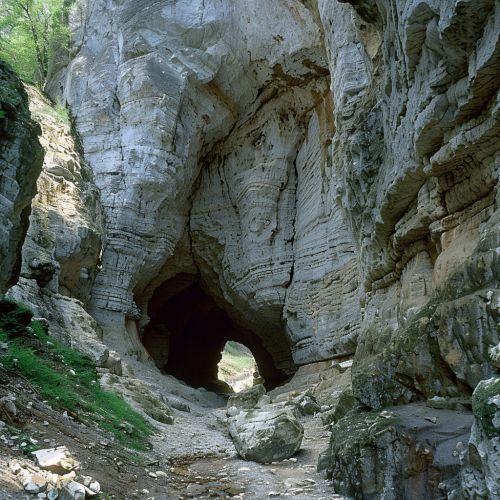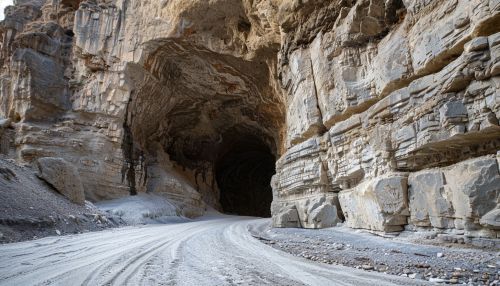Azykh Cave
Introduction
Azykh Cave, also known as Azokh Cave, is a significant archaeological and paleontological site located in the Lesser Caucasus mountains of Azerbaijan. This cave has yielded important findings that shed light on the prehistoric human occupation and the fauna of the region. The cave is particularly noted for its stratified deposits, which provide a continuous record of human activity and environmental changes over hundreds of thousands of years.
Location and Geology
Azykh Cave is situated in the Khojavend District of Azerbaijan, near the village of Azykh. The cave is part of a karst system formed in the limestone bedrock of the Lesser Caucasus. The geological formation of the cave is attributed to the dissolution of limestone by acidic water, which created a network of passages and chambers. The cave extends over several levels, with the main chamber being one of the largest and most significant for archaeological research.
Archaeological Significance
Early Discoveries
The first systematic excavations at Azykh Cave were conducted in the 1960s by a team of Azerbaijani and Soviet archaeologists led by Mammadali Huseynov. These initial excavations uncovered a wealth of artifacts, including stone tools, animal bones, and human remains. One of the most notable discoveries was a fragment of a lower jawbone, attributed to a Neanderthal individual, which was found in the lowest stratigraphic levels of the cave.


Stratigraphy and Dating
The stratigraphy of Azykh Cave is complex, with multiple layers of sediment representing different periods of occupation. The lowest layers date back to the Lower Paleolithic period, approximately 700,000 years ago. These layers contain evidence of early human activity, including Acheulean stone tools and faunal remains. The middle layers, dating to the Middle Paleolithic period, contain Mousterian tools and further evidence of Neanderthal occupation. The upper layers, from the Upper Paleolithic and later periods, contain artifacts associated with modern humans (Homo sapiens).
Faunal Remains
The faunal remains found in Azykh Cave provide valuable insights into the paleoenvironment and the subsistence strategies of its prehistoric inhabitants. The remains include a wide variety of species, such as cave bears, mammoths, and deer. The presence of cut marks on some of the bones indicates that early humans hunted and processed these animals for food. Additionally, the cave has yielded remains of smaller animals, such as rodents and birds, which help reconstruct the ecological conditions of the region during different periods.
Paleontological Findings
Azykh Cave is not only an important archaeological site but also a significant paleontological locality. The cave has preserved a rich assemblage of fossilized remains, which provide insights into the evolution and diversity of the region's fauna. Among the notable paleontological discoveries are the remains of extinct species, such as the Pleistocene cave bear (Ursus spelaeus) and the woolly mammoth (Mammuthus primigenius).
Human Occupation and Cultural Artifacts
Stone Tools
The stone tools recovered from Azykh Cave are representative of different technological traditions spanning the Lower to Upper Paleolithic periods. The Acheulean tools, characterized by bifacial handaxes and cleavers, are among the earliest artifacts found in the cave. These tools reflect the technological capabilities of early humans and their adaptation to the environment. The Mousterian tools, associated with Neanderthals, include scrapers, points, and denticulates, which were used for various tasks such as hunting, butchering, and hide processing. The Upper Paleolithic tools, attributed to modern humans, show a greater diversity and sophistication, including blades, burins, and bone tools.
Symbolic and Artistic Evidence
While Azykh Cave is primarily known for its utilitarian artifacts, there is also evidence of symbolic and artistic behavior. Some of the stone tools and bones exhibit engravings and other modifications that suggest early humans engaged in symbolic activities. These findings contribute to our understanding of the cognitive and cultural development of prehistoric humans in the region.
Research and Excavations
Soviet and Azerbaijani Excavations
The initial excavations at Azykh Cave were carried out by Soviet and Azerbaijani archaeologists, who laid the groundwork for future research. These early excavations focused on mapping the cave, documenting the stratigraphy, and recovering artifacts and faunal remains. The findings from these excavations were published in several scientific journals and monographs, which brought international attention to the site.
Recent Excavations and International Collaborations
In recent years, Azykh Cave has been the focus of renewed archaeological interest, with several international teams conducting excavations and research. These efforts have employed modern techniques, such as radiocarbon dating, DNA analysis, and 3D scanning, to gain new insights into the site's history and significance. The collaboration between Azerbaijani and international researchers has led to a more comprehensive understanding of the cave's archaeological and paleontological record.
Conservation and Preservation
Azykh Cave is a protected archaeological site, and efforts have been made to preserve its unique cultural and natural heritage. The cave is managed by the Azerbaijani government, which has implemented measures to prevent damage and looting. Additionally, ongoing research and conservation projects aim to document and preserve the site's artifacts and remains for future generations.
See Also
- Neanderthal
- Lower Paleolithic
- Acheulean
- Middle Paleolithic
- Upper Paleolithic
- Pleistocene
- Cave bear
- Woolly mammoth
